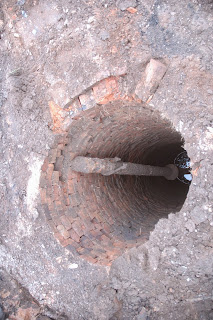The Lich St
tours have now ended after three weeks, with over 700 people coming with us
over to the roundabout to walk down the street, and others just coming to ask
us about the dig and the history of the site. It was great to be able to chat
to so many of you, especially all those who remembered Lich St and could share
memories with us.
Thank you very much for all who
have helped, both staff & volunteers, who have been down by the roundabout
in the vagaries of the British weather – Rob, Su, Justin, Andie, Ben, Simon,
Paul, Helen, Sarah, Roz, Luke, Steph, Mary, Carol & Rita. Thank you to
Richard as well his assistance and answering lots of questions.
We are about to hand the site over
to the construction team, for the next phase of the Cathedral Square
redevelopment. We'd built in this three week period for public access when we
could guarantee being able to take visitors down Lich St to see what was
uncovered. Now works to start filling in the cellars are taking place. If
this changes we'll let you know, but current plans means we cannot bring people
onto the site safely. A final archaeological excavation will take place
in the far south east corner of the site, where the cabin used to be, which
will just take a few days. As the site is now closed we will keep you informed
through the blog.
We are in the process of arranging
another couple of open days when we can show you a wider range of finds and photos,
as we did at St Helen's the other week. We may know a bit more about some of
the artefacts and have answered some of the questions we've had so even if you
came before there could be more to discover! This will be in around a month's
time and when we have the dates and location fixed we'll let you know.
The blog will continue to be
updated as we continue our work back in The Hive, working through the finds and
the information be obtained.































